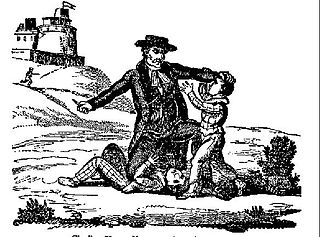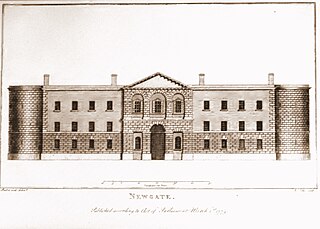See also
| This disambiguation page lists articles associated with the title Newgate Prison. If an internal link led you here, you may wish to change the link to point directly to the intended article. |
Newgate Prison was a prison in the City of London, in use between 1188 and 1902. Newgate Prison may also refer to:
| This disambiguation page lists articles associated with the title Newgate Prison. If an internal link led you here, you may wish to change the link to point directly to the intended article. |

Tyburn was a village in the county of Middlesex close to the current location of Marble Arch and the southern end of Edgware Road in present-day London. It took its name from the Tyburn Brook, a tributary of the River Westbourne. The name Tyburn, from Teo Bourne means 'boundary stream', but Tyburn Brook should not be confused with the better known River Tyburn, which is the next tributary of the River Thames to the east of the Westbourne.

Newgate Prison was a prison at the corner of Newgate Street and Old Bailey just inside the City of London, England, originally at the site of Newgate, a gate in the Roman London Wall. Built in the 12th century and demolished in 1904, the prison was extended and rebuilt many times, and remained in use for over 700 years, from 1188 to 1902.

East Granby is a town in Hartford County, Connecticut, United States. The population was 5,148 at the 2010 census.
Elizabeth Fry, often referred to as Betsy Fry, was an English prison reformer, social reformer and, as a Quaker, a Christian philanthropist. She has often been referred to as the "angel of prisons".

The Central Criminal Court of England and Wales is a court in London and one of a number of buildings housing the Crown Court. Part of the present building stands on the site of the medieval Newgate gaol, on a road named Old Bailey that follows the line of the City of London's fortified wall, which runs from Ludgate Hill to the junction of Newgate Street and Holborn Viaduct. The Old Bailey has been housed in several structures near this location since the sixteenth century, and its present building dates from 1902, designed by Edward William Mountford.

The Newgate Calendar, subtitled The Malefactors' Bloody Register, was a popular work of improving literature in the 18th and 19th centuries.

Ludgate was the westernmost gate in London Wall. The name survives in Ludgate Hill, an eastward continuation of Fleet Street, Ludgate Circus and Ludgate Square.

Newgate was one of the historic seven gates of the London Wall around the City of London and one of the six which date back to Roman times. From it, a Roman road led west to Silchester, Hampshire. Excavations in 1875, 1903 and 1909 revealed the Roman structure and showed that it consisted of a double roadway between two square flanking guardroom towers.

HM Prison Pentonville is an English Category B men's prison, operated by Her Majesty's Prison Service. Pentonville Prison is not in Pentonville, but is located further north, on the Caledonian Road in the Barnsbury area of the London Borough of Islington, north London. In 2015 the justice secretary, Michael Gove, described Pentonville as “the most dramatic example of failure” within the prisons estate.

Jack Sheppard, or "Honest Jack", was a notorious English thief and prison escapee of early 18th-century London. Born into a poor family, he was apprenticed as a carpenter but took to theft and burglary in 1723, with little more than a year of his training to complete. He was arrested and imprisoned five times in 1724 but escaped four times from prison, making him a notorious public figure, and wildly popular with the poorer classes. Ultimately, he was caught, convicted, and hanged at Tyburn, ending his brief criminal career after less than two years. The inability of the notorious "Thief-Taker General" Jonathan Wild to control Sheppard, and injuries suffered by Wild at the hands of Sheppard's colleague Joseph "Blueskin" Blake led to Wild's downfall.

St Sepulchre-without-Newgate, also known as the Church of the Holy Sepulchre (Holborn), is an Anglican church in the City of London. It is located on Holborn Viaduct, almost opposite the Old Bailey. In medieval times it stood just outside ("without") the now-demolished old city wall, near the Newgate. It has been a living of St John's College, Oxford, since 1622 and is part of the area designated the "Newgate Street Conservation Area" by the City of London Corporation.

Old Newgate Prison is a former prison and mine site on Newgate Road in East Granby, Connecticut. It is now operated by the state of Connecticut as the Old New-Gate Prison & Copper Mine Archaeological Preserve. Previously closed for restoration since 2009, it was re-opened on July 14, 2018. The site includes a colonial-era copper mine, and the remains of the state's first official prison, which was used between 1776 and 1782 to house prisoners of war from the American Revolutionary War. The site was designated a National Historic Landmark in 1972.

Newgate Prison was a place of detention in Dublin until its closure in 1863. It was initially located at Cornmarket, near Christ Church Cathedral, on the south side of the Liffey, and was originally one of the city gates.

Weehawken Street is a short street located in New York City's West Village, in the borough of Manhattan, one block from and parallel to West and Washington Streets, running between Christopher Street and West 10th Street.
The Giltspur Street Compter was a compter or small prison, designed by English architect and surveyor George Dance the Younger, mainly used to hold debtors. It was situated in Giltspur Street, Smithfield, close to Newgate, in the City of London, between 1791 and 1853.

The Connecticut Department of Correction (DOC) is the agency responsible for corrections in the U.S. state of Connecticut. The agency operates 18 correctional facilities. It has its headquarters in Wethersfield.

Viets' Tavern is an 18th-century tavern on Newgate Road, directly across the street from the Old Newgate Prison State Historical Site in East Granby, Connecticut. This 18th-century building was home for many years to the prison warden, who also operated it as a tavern. It was listed on the National Register of Historic Places in 1972.
James Pratt (1805–1835), also known as John Pratt, and John Smith (1795–1835) were two London men who, in November 1835, became the last two to be executed for sodomy in England. Pratt and Smith were arrested in August of that year after being convicted of having sex in the room of another man, William Bonill.

Henry House is a two-and-a-half-storey stone house located on Barrington Street in the Halifax Regional Municipality, Nova Scotia, Canada. The house is designated a National Historic Site, and is both a Provincially Registered Property and a Municipally Registered Property under the provincial Heritage Property Act.
Abel Starkey was a convicted counterfeiter whose death is closely tied to Old Newgate Prison after fatally falling during an escape attempt the night before the close of the prison. Starkey was from Roxbury, Massachusetts and became a counterfeiter. Members of a counterfeiting ring had eluded authorities for years, but they finally discovered the secret third attic of a lightning splitter home. Starkey was arrested, tried and convicted of counterfeiting. He was sentenced to a term of twenty years in the prison, where he would amass a sum of money. His attempt to escape ended in his death, accounts of Starkey's attempt continued to be popular in reference to the prison's history.